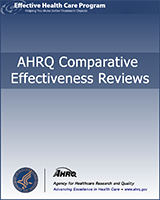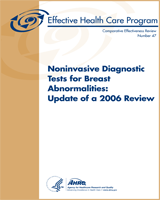NCBI Bookshelf. A service of the National Library of Medicine, National Institutes of Health.
Bruening W, Launders J, Pinkney N, et al. Effectiveness of Noninvasive Diagnostic Tests for Breast Abnormalities [Internet]. Rockville (MD): Agency for Healthcare Research and Quality (US); 2006 Feb. (Comparative Effectiveness Reviews, No. 2.)
This publication is provided for historical reference only and the information may be out of date.

Effectiveness of Noninvasive Diagnostic Tests for Breast Abnormalities [Internet].
Show detailsLiterature Searches
Details of our literature searches, which included searches of 11 electronic databases, hand searches of the bibliographies of all retrieved articles, and searches of the gray literature, are presented in Appendix A. Literature Search Strategies.
Inclusion/Exclusion Criteria for Questions 1 and 2
We used the following criteria to determine which studies would be included in our analysis:
- 1.
Study must evaluate the effectiveness of at least one of the non-invasive diagnostic technologies that are the focus of this report (PET scanning, scintimammography, MRI, ultrasound).
Other diagnostic technologies are outside the scope of this report.
- 2.
Used current generation scanners and protocols.
Studies of outdated technology (defined as studies published before 1991) and experimental technology are not relevant to current clinical practice.
- 3.
For studies of PET scanning, the study must have used 18-fluorodeoxyglucose as the tracer.
18-fluorodeoxyglucose is the standard tracer used in clinical practice. Studies of other tracers are outside the scope of this report.
- 4.
For studies of scintimammography, the study must have used 99mTc-sestamibi as the tracer.
This is the standard tracer used in clinical practice. Studies of other tracers are outside the scope of this report.
- 5.
For studies of MRI scanning, the study must have used a dedicated breast coil and a gadolinium-based contrast agent.
Use of a dedicated breast coil and a contrast agent are standard clinical practice. Studies of other types of contrast agents are outside the scope of this report.
- 6.
For studies of ultrasound, the study must have used gray-scale B-mode ultrasound with a transducer of 7 MHz or higher resolution.
Studies of tissue harmonics, color Doppler scanning, power Doppler scanning, or other methods are not standard clinical practice, and are outside the scope of this report.
- 7.
Study must report test sensitivity, specificity, negative or positive predictive values, or sufficient data to calculate these measures of diagnostic test performance
Other outcomes are beyond the scope of this report.
- 8.
Study must be published in English.
Translation costs prohibit the inclusion of studies published in other languages.
- 9.
Study must be published as a peer-reviewed full article. Meeting abstracts will not be included.
Published meeting abstracts have not been peer-reviewed and often do not include sufficient details about experimental methods to permit one to verify that the study was well designed. 24, 25 In addition, it is not uncommon for abstracts that are published as part of conference proceedings to describe studies that are never published as full articles. 26 – 29
- 10.
Enrolled human subjects.
Animal studies or studies of “phantoms” are outside the scope of the report.
- 11.
The study must have enrolled 10 or more individuals.
The results of small studies are typically more variable and less generalizable than those of larger studies. 30 – 32
- 12.
Study must not enroll individuals known to have mutations in BRCA1 or BRCA2, or individuals known to have a prior history of breast cancer, unless data from these populations are reported separately.
Women with BRCA1 or BRCA2 mutations, and women with a prior history of breast cancer, are outside the scope of this report. If more than 4% of the study population consists of such individuals, and the data for each population are not reported separately, the study is excluded.
- 13.
Study must enroll individuals found to have breast abnormalities by mammography or physical examination.
Primary screening studies are outside the scope of this report.
- 14.
Study must be prospective in design.
- 15.
Study must be either a randomized controlled trial or a prospective diagnostic cohort study.
Case-control studies, non-randomized controlled studies, and case reports were excluded.
- 16.
In diagnostic cohort studies, 85% or more of the patients must have been evaluated with both the diagnostic test of interest and biopsy.
Open surgical biopsy or core needle biopsy are both acceptable reference standards. 21 Fine needle aspiration followed by cytology is acceptable for evaluation of cystic lesions. For the purposes of this report, fine needle aspiration of solid lesions is not an acceptable reference standard. 33 – 36
- 17.
When several sequential reports from the same study center are available, only outcome data from the largest and most recent report were included. However, we used relevant data from earlier and smaller reports if the report presented pertinent data not presented in the larger, more recent report.
Data Abstraction
The following data were abstracted from the included trials: study design, details of imaging procedures, population characteristics (including sex, age, ethnicity), eligibility and exclusion criteria, information on thresholds used, and results for each outcome. Information abstracted from the included studies is presented in Appendix E. Evidence Tables.
- Evidence Base - Effectiveness of Noninvasive Diagnostic Tests for Breast Abnorma...Evidence Base - Effectiveness of Noninvasive Diagnostic Tests for Breast Abnormalities
Your browsing activity is empty.
Activity recording is turned off.
See more...
